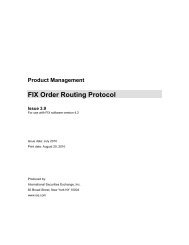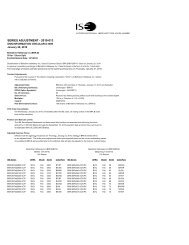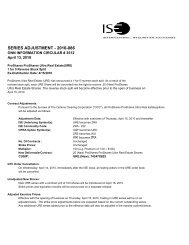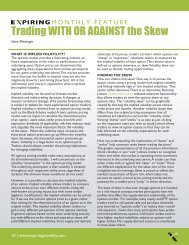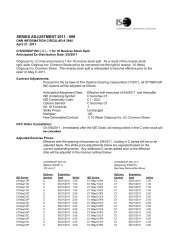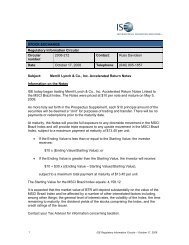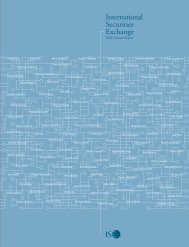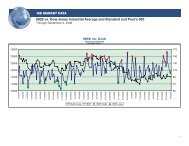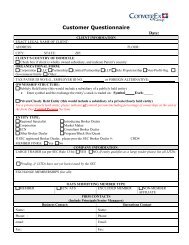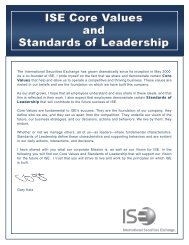Subject: Enhanced Electronic Blue Sheet Submissions - ISE.com
Subject: Enhanced Electronic Blue Sheet Submissions - ISE.com
Subject: Enhanced Electronic Blue Sheet Submissions - ISE.com
Create successful ePaper yourself
Turn your PDF publications into a flip-book with our unique Google optimized e-Paper software.
This <strong>com</strong>munication contains images that may be blocked by your email application. Please<br />
download images for proper viewing.<br />
Circular number: 2012- 03 Contact: Russ Davidson, Head of Market Surveillance<br />
Date:<br />
January 30,<br />
2012<br />
Telephone: (646) 805-1857<br />
<strong>Subject</strong>: <strong>Enhanced</strong> <strong>Electronic</strong> <strong>Blue</strong> <strong>Sheet</strong> <strong>Submissions</strong><br />
The International Securities Exchange, LLC (―<strong>ISE</strong>‖) and certain members of the Intermarket<br />
Surveillance Group (―ISG interested members‖) 1 are enhancing the <strong>Electronic</strong> <strong>Blue</strong> <strong>Sheet</strong>s (EBS) to<br />
improve the regulatory agencies’ ability to analyze broker-dealers’ trading activities.<br />
Effective August 31, 2012, firms will be required to submit new data elements to <strong>ISE</strong> and the other<br />
ISG interested members. Attachment A to this Circular sets forth the changes to the blue sheet record<br />
layout and Attachment B outlines the existing transaction type identifiers.<br />
In addition, effective August 31, 2012, firms will be required to submit blue sheets, when requested,<br />
in three additional formats: (1) account number and date; (2) account number, symbol and date; or (3)<br />
date range and executing firm CRD number or entering firm MPID.<br />
This Circular also provides answers to frequently asked questions (FAQ). The <strong>ISE</strong> and ISG interested<br />
members continue to collect questions and update the FAQ on the FINRA website<br />
(www.finra.org/bluesheets/faq). To support this effort, questions concerning the EBS enhancements<br />
should be directed to ebsfaq@finra.org.<br />
Discussion<br />
The <strong>ISE</strong> and ISG interested members are requiring firms to provide new data elements to EBS. The<br />
changes will take effect on August 31, 2012.<br />
To support these new data elements, the Securities Industry Automation Corporation (SIAC) has<br />
modified the blue sheet record layout. Changes to the blue sheet record layout are included as<br />
Attachment A. In addition, existing transaction type identifiers are outlined in Attachment B. Firms<br />
may begin testing the updated format starting on July 31, 2012.<br />
1 The interested members include the following exchanges and self-regulatory organizations (SROs) as members of the ISG: BATS Exchange,<br />
Inc., BATS Y-Exchange, Inc., Chicago Board Options Exchange, Incorporated, C2 Options Exchange, Incorporated, CBOE Stock Exchange,<br />
LLC, Chicago Stock Exchange, Inc., EDGA Exchange, Inc., EDGX Exchange, Inc., Financial Industry Regulatory Association (FINRA), The<br />
NASDAQ Stock Market LLC, NASDAQ OMX BX, Inc., NASDAQ OMX PHLX LLC, National Stock Exchange, Inc., New York Stock<br />
Exchange, LLC, NYSE Amex, LLC, and NYSE Arca, Inc.
In addition, the Securities and Exchange Commission (SEC) has mandated that the Large Trader<br />
Identification Number (LTID) and Order Execution Time enhancements be ready for transmission to<br />
the SEC by April 30, 2012. From April 30, 2012, through August 30, 2012, firms should submit these<br />
new data elements only to the SEC. After August 30, 2012, firms may voluntarily submit the LTID to<br />
<strong>ISE</strong> or the other ISG interested members. After August 30, 2012 firms will be required to submit the<br />
Order Execution Time to <strong>ISE</strong> or other ISG interested members.<br />
Firms should pay special attention to the following areas of Attachment A:<br />
Order Execution Time, Record Sequence Number Five, Field Position 72 to 77<br />
Firms should use this record to submit the order execution time in 24-hour format and in<br />
Eastern Time formatted as HHMMSS. This information is for all blue sheet transactions and<br />
is not limited to transactions relating to the SEC Large Trader Reporting Rule (SEA Rule<br />
13h-1). Please note that all firms must synchronize their time clocks to the atomic clock to<br />
maintain an accurate audit trail in connection to the reported execution time. (See Frequently<br />
Asked Question No. 3 below for more detail on clock synchronization requirements.)<br />
Large Trader Identification Number 1, Record Sequence Number Seven, Field Position<br />
2 to 14<br />
Firms should use this record to submit the LTID. This information is requested under the<br />
approved SEC Large Trader Reporting Rule (SEA Rule 13h-1) requirements.<br />
Large Trader Identification Number 2, Record Sequence Number Seven, Field Position<br />
15 to 27<br />
Firms should use this record to submit the LTID. This information is requested under the<br />
approved SEC Large Trader Reporting Rule (SEA Rule 13h-1) requirements.<br />
Large Trader Identification Number 3, Record Sequence Number Seven, Field Position<br />
28 to 40<br />
Firms should use this record to submit the LTID. This information is requested under the<br />
approved SEC Large Trader Reporting Rule (SEA Rule 13h-1) requirements.<br />
Large Trader Identification Qualifier, Record Sequence Number Seven, Field Position<br />
41<br />
Firms should use this record to submit the Large Trader Identification Qualifier. If more than<br />
three LTIDs exist for a transaction, then firms should mark the field ―Y‖ for Yes. Otherwise it<br />
should be marked ―N‖ for No. This information is requested under the approved SEC Large<br />
Trader Reporting Rule (SEA Rule 13h-1) requirements.<br />
Entering Firm MPID, Record Sequence Number Seven, Field Positions 42 to 45<br />
Firms should use this record to submit the entering firm’s Market Participant Identifier<br />
(MPID). The entering firm is the firm that entered the order on the marketplace.
Employer SIC Code, Record Sequence Number Seven, Field Positions 46 to 49<br />
Firms should use this record to submit the account holder’s employer SIC code. A list of<br />
employer SIC codes can be found at www.sec.gov/info/edgar/siccodes.htm.<br />
Executing Firm CRD Number, Record Sequence Number Seven, Field Positions 50 to 57<br />
Firms should use this record to submit the executing firm’s Central Registration Depository<br />
(CRD) number.<br />
Firms are reminded that failure to properly fill out the blue sheet fields is a violation of <strong>ISE</strong> Rule<br />
1404.<br />
<strong>Blue</strong> <strong>Sheet</strong> Submission Methodology<br />
Currently, blue sheet requests are made under specific security symbols and option symbology.<br />
Effective August 31, 2012, firms will be required to submit blue sheets, when requested, using three<br />
additional formats: (1) account number and date; (2) account number, symbol and date; or (3) date<br />
range and executing firm CRD number or entering firm MPID.<br />
The request by account number would require firms to identify the account number of a specific<br />
account at a firm, e.g. John Doe at CC Clearing Co. The request would cover all transactions under<br />
the John Doe account number at CC Clearing Co. To reduce data submission size, a blue sheet request<br />
may also ask for a specific symbol and date in connection with the account number. Additionally, blue<br />
sheet requests may be made for a specific review period under an executing firm CRD number or<br />
entering firm MPID. This request would require a firm to identify a clearing firm client’s blue sheets<br />
for a set number of days, weeks or months, e.g. Firm ABC for the month of January 2011.<br />
Frequently Asked Questions<br />
Q1. Is there a testing period for the enhanced blue sheets<br />
A1. Yes, <strong>ISE</strong> and all ISG interested members will be ready to accept the updated blue sheet data<br />
and layout starting July 31, 2012. Please contact Michal Skibicki at SIAC (212) 383-9073,<br />
mskibicki@nyx.<strong>com</strong>) for initial testing instructions before submitting the first enhanced blue<br />
sheet.<br />
Q2. For a blue sheet request with multiple issues under the same investigation number, how<br />
should the submission be made<br />
A2. <strong>ISE</strong> and the ISG interested members will accept multiple symbols submitted under one<br />
investigation number. Firms can also submit blue sheets using each symbol and produce separate<br />
records for each symbol. It is re<strong>com</strong>mended that firms submit the blue sheet <strong>com</strong>bining all<br />
symbols on one blue sheet submission to reduce the overall number of submissions.
Q3. What time zone should be used for reporting the execution time<br />
A3. Execution time should be reported in Eastern Time. Firms must synchronize their time clocks<br />
with the atomic clock every business day before market open. To maintain clock synchronization,<br />
clocks should be checked against the standard clock and re-synchronized, if necessary, at predetermined<br />
intervals throughout the day. The reported time must be reported in a 24-hour format<br />
as HHMMSS. A firm must ensure that the business clocks it uses are accurate to within onesecond<br />
of the National Institute of Standards and Technology Atomic Clock in Boulder Colorado<br />
(NIST Clock) or the United States Naval Observatory Master Clock in Washington, D.C., (USNO<br />
Master Clock) and must immediately recalibrate its clocks if the drift is greater than one second.<br />
This includes all of the following:<br />
(1) the difference between the NIST/USNO standard and a time provider's clock;<br />
(2) transmission delay from the source; and<br />
(3) the amount of drift of the firm's business clock.<br />
A firm’s written supervisory procedures must include a description of how the firm conducts,<br />
documents and maintains synchronization of its business clocks.<br />
Q4. If the entering firm does not have an MPID, can I leave the field blank<br />
A4. Yes, this field may be blank if the entering firm does not have an assigned MPID.<br />
Q5. How can I locate the list of Employer SIC Codes for use in the blue sheets<br />
A5. A list of employer SIC codes can be found at www.sec.gov/info/edgar/siccodes.htm<br />
Q6. If a client order is facilitated through an “Average Price Facilitation Account,” but the<br />
resulting execution of the order is filled through a single execution, should the transaction<br />
be reported as “average price”<br />
A6. Yes, this execution should be reported as ―average price.‖<br />
Q7. If a clearing firm receives a batch file from a firm that consolidates executions and<br />
reports them as average price executions, can that same consolidated execution report be<br />
submitted on the blue sheets<br />
A7. No, the underlying executions must be reported. Even if a clearing firm is batch processing<br />
aggregate and/or consolidated execution information for continuous net settlement purposes, the<br />
underlying trades that were reported to the tape must be reported on the blue sheets. Firms that are<br />
unable to provide the underlying trade information must inform FINRA of this before submitting<br />
a blue sheet.<br />
Q8. If a clearing firm receives a batch file from a firm that consolidates executions, can that<br />
same consolidated execution report be submitted on the blue sheets<br />
A8. No, the underlying trades that were reported to the tape must be reported on the blue sheets.<br />
Firms that are unable to provide the underlying trade information must inform <strong>ISE</strong> of this before<br />
submitting a blue sheet.
Q9. If a firm receives a request for historical data, will the enhanced blue sheet data format<br />
be required<br />
A9. No, the enhancements will be required for data beginning August 31, 2012. Requests for<br />
older data will not require submission of enhanced blue sheet data elements.<br />
Q10. Will the options symbology requirements now change<br />
A10. No, the symbol field must contain OPTIONXX when Record 6 contains option data. If the<br />
symbol field does not contain OPTIONXX, Record 6 should default to blanks in FIELD<br />
POSITIONS 2 through 80, and then add Record Sequence Number Seven. Please refer to the prior<br />
<strong>Blue</strong> <strong>Sheet</strong>s Options Symbology (OSI) requirements as described in FINRA Regulatory Notice<br />
09-18.<br />
Q11. For purposes of the SEC Large Trader Reporting Rule (SEA Rule 13h-1), what is the<br />
format of the LTID and the optional suffix<br />
A11. An LTID can be a maximum of 13 characters. Specifically, 8 characters for the LTID,<br />
followed by a dash, with 4 maximum characters for the optional suffix. As specified in the<br />
Instructions to Form 13H, suffixes should initially be limited to three characters. Numbers should<br />
be right-justified and zeros should be used in place of blanks.<br />
Q12. For purposes of the SEC Large Trader Reporting Rule (SEA Rule 13h-1), how should<br />
Unidentified Large Traders be designated<br />
A12. For Unidentified Large Traders, broker-dealers should assign their own unique identifying<br />
number to each person identified as an Unidentified Large Trader. The number should conform to<br />
the format for the LTID and should begin with the letters ―ULT‖. For example, ―ULT00001‖.<br />
The FAQ will be updated from time to time. Please see FINRA’s website<br />
www.finra.org/bluesheets/faq for the most recent version.
Attachment A<br />
Record Layout for Submission of Trading Information<br />
Field<br />
Position<br />
From To<br />
Field<br />
Length<br />
Field<br />
Name/Description/Remarks<br />
Field<br />
Format<br />
Justify<br />
Picture<br />
Clause<br />
Default Value<br />
***This record must be the first<br />
record of the file***<br />
1 3 3 FILLER A LJ X(3) HDR<br />
4 5 2 FILLER A LJ X(2) .S<br />
6 10 5 DTRK-SYSID N LJ 9(5) 12343<br />
11 12 2 FILLER A LJ X(2) .E<br />
13 14 2 FILLER N LJ 9(2) 00<br />
15 16 2 FILLER A LJ X(2) .C<br />
17 20 4<br />
DTRK-ORIGINATOR<br />
Please call SIAC for assignment A LJ X(4) --<br />
(212) 383-2210<br />
21 22 2 FILLER A LJ X(2) .S<br />
23 26 4<br />
DTRK-SUB-ORIGINATOR<br />
Please call SIAC for assignment A LJ X(4) --<br />
(212) 383-2210<br />
27 27 1 FILLER A LJ X(1) B<br />
28 33 6<br />
DTRK-DATE<br />
Contains submission date.<br />
N LJ 9(6) MMDDYY<br />
34 34 1 FILLER A LJ X(1) B<br />
35 59 25<br />
DTRK-DESCRIPTION<br />
Required to identify this file.<br />
A LJ X(25)<br />
FIRM<br />
TRADING<br />
INFORMATION<br />
60 80 21 FILLER A LJ X(21) B<br />
1 1 1<br />
HEADER RECORD CODE<br />
Value: Low Values OR ZERO<br />
A -- X --<br />
2 5 4<br />
SUBMITTING BROKER<br />
NUMBER<br />
If NSCC member use NSCC<br />
clearing number.<br />
A–R LJ X(4) B<br />
If not a NSCC member, use<br />
clearing number assigned to you by<br />
your clearing agency.<br />
6 40 35<br />
FIRM'S REQUEST NUMBER<br />
Tracking number used by the firm<br />
to record requests from an<br />
A -- X(35) B<br />
organization.<br />
41 46 6<br />
FILE CREATION DATE<br />
Format is YYMMDD<br />
A -- X(6) --
47 54 8<br />
55 55 1<br />
FILE CREATION TIME<br />
Format is HH:MM:SS<br />
REQUESTOR CODE<br />
Requesting Organization<br />
Identification Values:<br />
A = New York Stock Exchange<br />
B = NYSE AMEX<br />
C = Chicago Stock Exchange<br />
D = NASDAQ OMX<br />
E = NYSE Arca<br />
F = Boston Stock Exchange<br />
G = National Stock Exchange<br />
H = BATS Trading<br />
I = International Securities<br />
Exchange<br />
J = Direct Edge<br />
K = Chicago Board Options<br />
Exchange, C2 Options Exchange<br />
and CBOE Stock Exchange<br />
R = FINRA<br />
X = Securities Exchange<br />
Commission<br />
Y = BATS Y-Exchange<br />
Z = Other<br />
A -- X(8) --<br />
A -- X --<br />
56 70 15<br />
REQUESTING ORGANIZATION<br />
NUMBER<br />
Number assigned by requesting<br />
A LJ X(15) B<br />
organization<br />
71 80 10 FILLER A -- X(10) B<br />
1 1 1<br />
RECORD SEQUENCE NUMBER<br />
ONE<br />
The first record of the transaction.<br />
A -- X --<br />
Value: 1<br />
2 5 4<br />
SUBMITTING BROKER<br />
NUMBER<br />
Identical to Submitting Broker<br />
A–R LJ X(4) --<br />
Number in Header Record<br />
6 9 4<br />
OPPOSING BROKER NUMBER<br />
The NSCC clearing house number<br />
of the broker on the other side of<br />
A–R LJ X(4) B<br />
the trade.<br />
10 21 12<br />
CUSIP NUMBER<br />
The cusip number assigned to the<br />
security.<br />
A LJ X(12) B
22 29 8<br />
30 35 6<br />
36 41 6<br />
42 53 12<br />
54 67 14<br />
68 68 1<br />
69 78 10<br />
Left justified since the number is<br />
nine characters at present (8+<br />
check digit) but will expand in the<br />
future.<br />
TICKER SYMBOL<br />
The symbol assigned to this<br />
security. For options (pre-OSI), the<br />
OPRA option symbol (space),<br />
OPRA expiration month symbol<br />
and OPRA strike price symbol<br />
should be used. (Ex. Maytag May<br />
20 call option series would be<br />
reported as MYG ED. This<br />
A–R<br />
example uses six spaces in the field<br />
LJ X(8) B<br />
with a space between the OPRA<br />
symbol and the OPRA expiration<br />
month.)<br />
Post OSI this field must contain<br />
OPTIONXX and a Record<br />
Sequence Number Six must be<br />
<strong>com</strong>pleted<br />
TRADE DATE<br />
The date this trade executed.<br />
Format is YYMMDD.<br />
SETTLEMENT DATE<br />
The date this trade will settle.<br />
Format is YYMMDD<br />
QUANTITY<br />
The number of shares or quantity<br />
of bonds or option contracts.<br />
NET AMOUNT<br />
The proceeds of sales or cost of<br />
purchases after <strong>com</strong>missions and<br />
other charges.<br />
A–R -- X(6) B<br />
A -- X(6) B<br />
N–R RJ 9(12) Z<br />
N<br />
RJ<br />
S9(12)<br />
V99<br />
BUY/SELL CODE<br />
Values: 0 = Buy, 1 = Sale, 2 =<br />
Short Sale, 3 = Buy Open, 4 = Sell<br />
Open, 5 = Sell Close, 6 = Buy<br />
Close. A = Buy Cancel, B = Sell<br />
A–R<br />
Cancel, C = Short Sale Cancel, D =<br />
-- X B<br />
Buy Open Cancel, E = Sell Open<br />
Cancel, F = Sell Close Cancel, G =<br />
Buy Close Cancel. Values 3 to 6<br />
and D to G are for options only<br />
PRICE<br />
The transaction price. Format: N–R RJ 9(4)V(6) Z<br />
$$$$ CCCCCC.<br />
Z
79 79 1<br />
80 80 1<br />
1 1 1<br />
2 2 1<br />
3 4 2<br />
EXCHANGE CODE<br />
Exchange where trade was<br />
executed. Values:<br />
A = New York Stock Exchange<br />
B = NYSE AMEX<br />
C = Chicago Stock Exchange<br />
D = NASDAQ OMX PHLX<br />
E = NYSE Arca<br />
F = Boston Stock Exchange<br />
G = National Stock Exchange<br />
H = BATS Trading<br />
I = International Securities<br />
Exchange<br />
J = C2 Options Exchange<br />
K = Chicago Board Options<br />
Exchange<br />
L = London Stock Exchange<br />
M =Toronto Stock Exchange<br />
N = Montreal Stock Exchange<br />
O =TSX Venture Exchange<br />
P = DirectEdge A<br />
Q=FINRA ADF<br />
R = NASDAQ/NASDAQ Options<br />
Market<br />
S = Over-the-Counter<br />
T = Tokyo Stock Exchange<br />
V = DirectEdge X<br />
W = CBSX (CBOE Stock<br />
Exchange)<br />
X = NASDAQ OMX PSX<br />
Y = BATS Y-Exchange<br />
Z = Other<br />
BROKER/DEALER CODE<br />
Indicate if trade was done for<br />
another Broker/Dealer.<br />
Values: 0 = No; 1 = Yes<br />
RECORD SEQUENCE NUMBER<br />
TWO<br />
Value: 2<br />
SOLICITED CODE<br />
Values: 0 = No; 1 = Yes<br />
STATE CODE<br />
Standard Postal two character<br />
A–R -- X B<br />
A–R -- X B<br />
A -- X --<br />
A–R -- X B<br />
A–R -- X(2) B
identification.<br />
5 14 10<br />
ZIP CODE/COUNTRY CODE<br />
Zip Code—five or nine character<br />
(zip plus four)<br />
A–R LJ X(10) B<br />
Country code—for future use.<br />
15 22 8<br />
BRANCH OFFICE/REGISTERED<br />
REPRESENTATIVE NUMBER<br />
Each treated as a four-character A–R LJ X(8) B<br />
field.<br />
Both are left justified.<br />
23 28 6<br />
DATE ACCOUNT OPENED<br />
Format is YYMMDD<br />
A–R -- X(6) B<br />
29 48 20<br />
SHORT NAME FIELD<br />
Contains last name followed by<br />
<strong>com</strong>ma (or space) then as much of<br />
A LJ X(20) B<br />
first name as will fit.<br />
49 78 30 EMPLOYER NAME A LJ X(30) B<br />
79 79 1<br />
TIN 1 INDICATOR<br />
Values: 1 = SS#; 2 = TIN<br />
A–R -- X B<br />
80 80 1<br />
TIN 2 INDICATOR<br />
Values: 1 = SS#; 2 = TIN—for A -- X B<br />
future use.<br />
1 1 1<br />
RECORD SEQUENCE NUMBER<br />
THREE<br />
A -- X --<br />
Value: 3<br />
2 10 9<br />
TIN ONE<br />
Taxpayer Identification Number A–R LJ X(9) B<br />
Social Security or Tax ID Number.<br />
TIN TWO<br />
11 19 9 Taxpayer Identification Number #2 A LJ X(9) B<br />
Reserved for future use.<br />
20 20 1 NUMBER OF N&A LINES A -- X B<br />
21 50 30<br />
NAME AND ADDRESS LINE<br />
ONE<br />
A–R LJ X(30) B<br />
51 80 30<br />
NAME AND ADDRESS LINE<br />
TWO<br />
A–R LJ X(30) B<br />
1 1 1<br />
RECORD SEQUENCE NUMBER<br />
A<br />
FOUR<br />
-- X --<br />
Value: 4<br />
2 31 30<br />
NAME AND ADDRESS LINE<br />
THREE<br />
A–R LJ X(30) B<br />
32 61 30<br />
NAME AND ADDRESS LINE<br />
FOUR<br />
A–R LJ X(30) B<br />
62 62 1<br />
TRANSACTION TYPE<br />
IDENTIFIERS<br />
See Attachment B for current<br />
A–R -- X B
codes.<br />
63 80 18<br />
ACCOUNT NUMBER<br />
Account number<br />
A–R LJ X(18) B<br />
1 1 1<br />
RECORD SEQUENCE NUMBER<br />
FIVE<br />
A -- X(1) --<br />
Value: 5<br />
2 31 30<br />
NAME AND ADDRESS LINE<br />
FIVE<br />
A–R LJ X(30) B<br />
32 61 30<br />
NAME AND ADDRESS LINE<br />
SIX<br />
A–R LJ X(30) B<br />
62 65 4<br />
PRIME BROKER<br />
Clearing number of the account's A–R LJ X(4) B<br />
prime broker.<br />
66 66 1<br />
AVERAGE PRICE ACCOUNT<br />
1 = recipient of average price<br />
transaction.<br />
N–R -- 9(1) Z<br />
2 = average price account itself.<br />
DEPOSITORY INSTITUTION<br />
IDENTIFIER<br />
67 71 5 Identifying number assigned to the A–R LJ X(5) B<br />
account by the depository<br />
institution.<br />
Order Execution Time<br />
72 77 6<br />
HHMMSS – Time format will be<br />
in Eastern Time and 24 hour<br />
N LJ -- --<br />
format.<br />
78 80 3 FILLER A -- X B<br />
RECORD SEQUENCE NUMBER<br />
1 1 1 SIX<br />
A -- --<br />
Value: 6<br />
2 9 8<br />
DERIVATIVE SYMBOL<br />
The symbol assigned to the A LJ -- B<br />
derivative<br />
EXPIRATION DATE<br />
10 15 6 The date the option expires. Format A -- -- B<br />
is YYMMDD<br />
16 16 1<br />
CALL/PUT INDICATOR<br />
C = Call, P = Put<br />
A -- -- B<br />
17 24 8<br />
STRIKE DOLLAR<br />
The dollar amount of the strike N RJ -- Z<br />
price<br />
25 30 6<br />
STRIKE DECIMAL<br />
The decimal amount of the strike N RJ -- Z<br />
price<br />
31 80 50 FILLER A LJ -- B<br />
1 1 1 RECORD SEQUENCE NUMBER A -- --
SEVEN<br />
Value: 7<br />
2 14 13 Large Trader Identification 1 A RJ -- Z<br />
15 27 13 Large Trader Identification 2 A RJ -- Z<br />
28 40 13 Large Trader Identification 3 A RJ -- Z<br />
41 41 1<br />
Large Trader Identification<br />
Qualifier<br />
A RJ -- Z<br />
42 45 4 Entering Firm MPID A LJ -- B<br />
46 49 4 Employer SIC Code N LJ -- B<br />
50 57 8 Executing Firm CRD Number N LJ -- B<br />
58 80 23 FILLER A LJ -- B<br />
1 1 1<br />
TRAILER RECORD DATE<br />
One record per submission. Must<br />
be the last record on the file.<br />
A -- X --<br />
Value: High Values or "9"<br />
2 17 16<br />
TOTAL TRANSACTIONS<br />
The total number of transactions.<br />
This total excludes Header and<br />
N RJ 9(16) B<br />
Trailer Records.<br />
18 33 16<br />
TOTAL RECORDS ON FILE<br />
The total number of 80 byte<br />
records. This total includes Header<br />
and Trailer Records, but not the N RJ 9(16) Z<br />
Datatrak Header Record (i.e., it<br />
does not include the first record on<br />
the file).<br />
34 80 47 FILLER A -- X(47) B<br />
Field Format<br />
A = Alphanumeric (all caps)<br />
N = Numeric<br />
P = Packed<br />
B = Binary<br />
R = Validation Required<br />
Default<br />
Values—<br />
Code<br />
B =<br />
Blanks<br />
Z= Zero<br />
Justify<br />
RJ = Right<br />
Justification<br />
of Data<br />
LJ = Left<br />
Justification<br />
of Data
Attachment B<br />
Record Layout for Submission of Trading Information<br />
Transaction Type<br />
Security Type<br />
Equity* Options<br />
Non-Program Trading, Agency A C<br />
Non-Index Arbitrage, Program Trading, Proprietary<br />
C<br />
Index Arbitrage, Program Trading, Proprietary<br />
D<br />
Index Arbitrage, Program Trading, Individual Investor<br />
J<br />
Non-Index Arbitrage, Program Trading, Individual Investor<br />
K<br />
Non-Program Trading, Proprietary P F<br />
Non-Program Trading, Individual Investor<br />
I<br />
Non-Index Arbitrage, Program Trading, Agency<br />
Y<br />
Index Arbitrage, Program Trading, Agency<br />
U<br />
Index Arbitrage, Program Trading, as Agent for Other Member<br />
M<br />
Non-Index Arbitrage, Program Trading, as Agent for Other Member<br />
N<br />
Non-Program Trading, as Agent for Other Member<br />
W<br />
Specialist S S<br />
Market-Maker<br />
M<br />
Non-Member Market-Maker/Specialist Account<br />
N<br />
Stock Specialist — Assignment<br />
Y<br />
Short Exempt, Agency<br />
B<br />
Customer Range Account of a Broker/Dealer<br />
B<br />
Registered Trader<br />
G<br />
Error Trade<br />
Q<br />
Competing Market Maker Proprietary Transaction: Affiliated w/ Clearing Member O<br />
Competing Market Maker: Unaffiliated Member's Competing Market Maker<br />
T<br />
Competing Market Maker: Non-Member<br />
R<br />
Short Exempt Transaction: Proprietary Account of Clearing Member Organization or<br />
Affiliated Member/Member Organization<br />
E<br />
Short Exempt Transaction: Proprietary Account of Unaffiliated Member/Member<br />
Organization<br />
F<br />
Short Exempt Transaction: Individual Customer Account<br />
H<br />
Short Exempt Transaction: Competing Market Maker this is a Member/Member<br />
Organization Trading for own account<br />
L<br />
Short Exempt Transaction: One Member Acting as Agent for Another Member's<br />
Competing Market Maker Account<br />
X<br />
Short Exempt Transaction: Account of Non Member Competing Market Maker<br />
Z<br />
Amex Option Specialist/Market Maker Trading Paired Security<br />
V
Registered Trader Market Maker Transaction Regardless of the Clearing Number<br />
Transactions cleared for a NASDAQ market maker that is affiliated w/ the clearing<br />
member that resulted from telephone access to the specialist. Amex Only.<br />
Transactions cleared for a member's NASDAQ market maker that is not affiliated with<br />
the clearing member that resulted from telephone access to the specialist. Amex Only.<br />
Transactions cleared for a non-member NASDAQ market maker that is not affiliated<br />
with the clearing member that resulted from telephone access to the specialist. Amex<br />
Only.<br />
Voluntary Professional<br />
3<br />
4<br />
5<br />
P<br />
W<br />
* Equity securities include those securities that trade like equities (e.g., ETFs and structured<br />
products).



